Native Plant Road Trip to Bryan
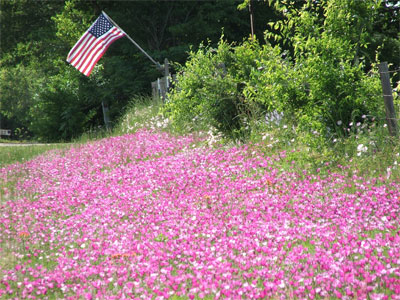
Old Glory waves above a field of winecups (Callirhoe digitata or C. involucrata). All photos by Steven Chamblee.
Catalpa and Woolly White
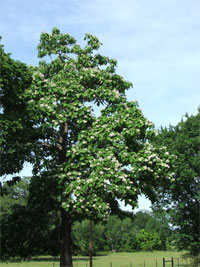
Northern catalpa (Catalpa speciosa).
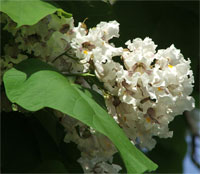
Cluster of catalpa blossoms.
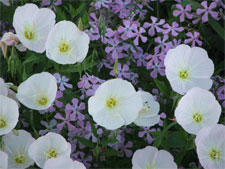
Primroses and phlox.
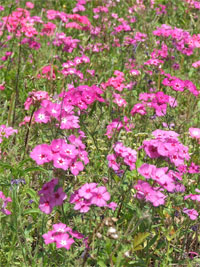
Phlox (Phlox drummondii or P. pilosa).

White prickly poppy (Argemone albiflora).
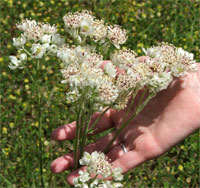
Woolly-white (Hymenopappus artemisifolius).
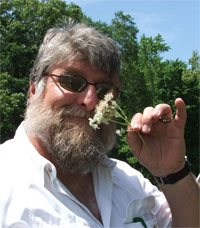
Steven overdoses on woolly white.
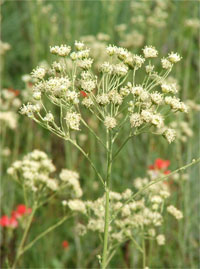
Old plainsman (H. tenuifolius).
Is it just me, or does the dynamic duo of April-May blow everybody’s mind? Two weeks ago today, I was Mr. Horticulture down in Bryan, giving a talk to those pumped-up Brazos County Master Gardeners. The next morning, I was Mr. Instructor at The Arbor Gate in Tomball. Two days ago, I was Mr. Waterfall Pump Repairman, covered in scum, slime and stink. Three hours ago, I was playing Mr. Giant Hedge Trimmer (and I’ve still got little fragments of cherry laurel in my ears to prove it!). Two hours ago, I took a drive down good ole Garner Road, making a go of Mr. Photographer. Two minutes ago, I fired up the decaf chai tea … enter Mr. Mellow. (And if that doesn’t work, I may try something stronger.)
I assume that everybody reading this is aware by now that the sweet little stretch of Hwy. 21 between Madisonville and Bryan is pure wildflower magic, especially there around North Zulch. (Never could find Zulch or South Zulch on the map, but then again, I couldn’t find “kempt” in the dictionary either.) Anyway, a fella like me can’t help but pull off the road half a dozen times or so, every 15 minutes, to take wildflower photos. More than a few folks honk … like I’m saddling up to that fencepost for some other reason! Shoot, man, I was just at Buc-ee’s 15 miles back, topping off one tank and draining the other, so I’m in good shape.
A killer specimen of northern catalpa (Catalpa speciosa) brings my little truck to a quick stop on the equivalent of Blind Man’s Curve, though I don’t know that until a semi on a dead-head run nearly trims my beard for me. Now, I’ve heard lots of people call this “southern catalpa,” probably because it grows in “The South” and many of us folks have an aversion to anything from “up north.” Truth is, there are other catalpas, but they grow south of here, which makes us “up north” to them. (Even more catalpas grow in eastern Asia, as part of that mysterious “Arcto-Tertiary Flora” thing that links that part of the world with this part of the world. Google it if you’re curious.) Anyway, the whole tree is smothered in big ol’ clusters (perhaps 50 to 70 flowers per cluster) of inch-wide, frilly, white blossoms with purple-splotched throats. (Sound like desert willow? — same family, Bignoniaceae.) The heart-shaped leaves on this tree are quite lovely, and can reach a foot across. As if that isn’t enough, its other common name is cigartree, for those pencil-thick, 18-inch-long brown capsules that dangle from the tree from summer through mid-winter.
Just up the highway, it’s like a wildflower guide come to life. Evening primrose, Indian blanket, Barbara’s buttons … I’m getting dizzy. Old Glory waves proudly, the finishing touch to a magnificent patch of winecup (Callirhoe digitata or C. involucrata). Across the road, a nice stand of phlox (Phlox drummondii or P. pilosa) brightens up a bar ditch. Not far away, white prickly poppy (Argemone albiflora) is pulling off the perfect Jekyll and Hyde act — a delicate puffball of yellow stamens gently crowning a circle of white, silky, gossamer petals … all atop the orneriest, prickliest beast of a plant you could ever imagine. (And I even like pokey plants!) It even oozes a bright yellow sap when cut. Should be renamed: Dove on a Devil … Virgin Sacrifice … White Satin Death … Panties on a Panther….
Ahem … moving right along….
I am soon completely captivated by a wildflower with what I consider the most beautiful fragrance of all, woolly-white (Hymenopappus artemisifolius). Clusters of perhaps 50 small, red-tinged, white blossoms wave cheerily in the wind atop 2- to 3-foot stems adorned with wormwood-like foliage. Held close to the nose, it tantalizes you with its rich scent … I can only describe it as caramelized, warm vanilla honey. One deep lungful and I’m a goner, but I keep huffing. It overdoses my olfactories, saturates my senses, and intoxicates my innards. I begin to move without intention, swirling about in this nectar-induced nirvana. Music fills my ears, my heart, my mouth. Time stands still. Someone honks. I awaken to find myself on the double yellow line. A line of cars has stopped. I see parents covering their children’s eyes. Apparently, the people around here aren’t used to seeing a big, hairy man in the middle of the road doing a modified foxtrot while singing Johnny Mathis’ “Chances Are” and sniffing the local flora. Well, folks, I’m not done yet, so I continue, “… because I wear a silly grin….”
Thank heaven the sheriff was busy getting rid of troublemakers. All too soon, as the miles roll by and I get closer to Weatherford, soils change and my woolly-white gradually gives way to its cousin, old plainsman (H. tenuifolius). I stop. I sniff. I swoon….
“It’s a yum-yummy world made for sweethearts….”
About the author: Steven Chamblee is the chief horticulturist for Chandor Gardens in Weatherford and a regular contributor to Neil Sperry’s GARDENS magazine and e-gardens newsletter. Steven adds these notes:
********
EARTHcamp is coming to Chandor Gardens! Created by John Denver’s Windstar Foundation, this unique day camp for grades 4-6 fosters a love and respect for the earth. Science, games, art, drama, and music are all part of a curriculum professionally designed to educate, inspire, and empower children and adults to make intelligent environmental decisions. Join us for EARTHcamp June 14-18, from 9 a.m. to 4 p.m. daily. Registration deadline is June 4. Tuition is $150 per camper; $125 for each additional sibling. For more info, e-mail Barbara Davis at wdavis99@charter.net, or call 817-613-1700.
Come out to Chandor Gardens and see us sometime. Just take I-20 west to exit 409, hang a right, go 2.1 miles and hang a left on Lee Avenue. Head straight 12 blocks and you’re driving in the gates. Call 817-361-1700 to let us know you’re coming, and we’ll light the incense and show you around. You can always go to www.chandorgardens.com for a picture tour and more information.
I can always use another road trip! Let me know if you’d like me to come out and speak to your group sometime. I’m low-maintenance, flexible, and you know I like to go just about anywhere. No city too big; no town to small. Just send me an e-mail at schamblee@weatherfordtx.gov and we’ll work something out.

